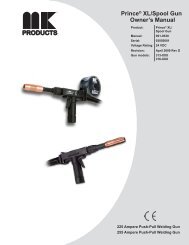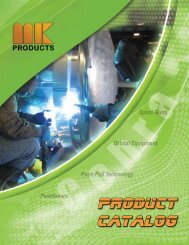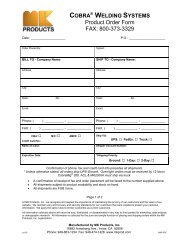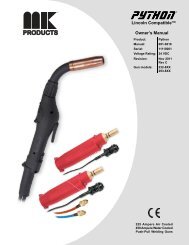You also want an ePaper? Increase the reach of your titles
YUMPU automatically turns print PDFs into web optimized ePapers that Google loves.
intended to protect any downstream equipment.Provide such protection with one or more reliefdevices.Never connect a regulator to a cylinder containinggas other than that for which the regulatorwas designed.Remove faulty regulator from service immediatelyfor repair (fi rst close cylinder valve). Thefollowing symptoms indicate a faulty regulator:Leaks - if gas leaks externally.Excessive Creep - if delivery pressure continuesto rise with downstream valve closed.Faulty Gauge - if gauge pointer does not moveoff stop pin when pressurized, nor returns tostop pin after pressure release.Repair. Do NOT attempt repair. Send faultyregulators for repair to manufacturer’s designatedrepair center, where special techniquesand tools are used by trained personnel.2. CylindersCylinders must be handled carefully to preventleaks and damage to their walls, valves, orsafety devices:Avoid electrical circuit contact with cylindersincluding third rails, electrical wires, or weldingcircuits. They can produced short circuit arcsthat may lead to a serious accident. (See 1-3C)ICC or DOT marking must be on each cylinder.It is an assurance of safety when the cylinder isproperly handled.Identifying gas content. Use only cylinders withname of gas marked on them; do not rely oncolor to identify gas content. Notify supplierif unmarked. NEVER DEFACE or alter name,number, or other markings on a cylinder. It isillegal and hazardous.Empties: Keep valves closed, replace capssecurely; mark MT; keep them separate fromFULLS, and return promptly.Prohibited use. Never use a cylinder or its contentsfor other than its intended use, NEVER asa support or roller.Locate or secure cylinders so they cannot beknocked over.Passageways and work areas. Keep cylindersclear of areas where they may be stuck.Transporting cylinders. With a crane, use asecure support such as a platform or cradle. DoNOT lift cylinders off the ground by their valvesor caps, or by chains, slings, or magnets.Do NOT expose cylinders to excessive heat,sparks, slag, and fl ame, etc. that may causerupture. Do not allow contents to exceed 55degrees C (130 degrees F.) Cool with waterspray where such exposure exists.Protect cylinders, particularly valves frombumps, falls, falling objects, and weather.Replace caps securely when moving cylinders.Stuck valve. Do NOT use a hammer or wrenchto open a cylinder valve that cannot be openedby hand. Notify your supplier.Mixing gases. NEVER try to mix any gases ina cylinder.NEVER refi ll any cylinder.Cylinder fi ttings should never be modifi ed orexchanged.3. HoseProhibited use. Never use hose other than thatdesigned for the specifi ed gas. A general hoseidentifi cation rule is: red for fuel gas, green foroxygen, and black for inert gases.Use ferrules or clamps designed for the hose (notordinary wire or other substitute) as a binding toconnect hoses to fi ttings.No copper tubing splices. Use only standard brassfi ttings to splice hose.Avoid long runs to prevent kinks and abuse.Suspend hose off ground to keep it from being runover, stepped on, or otherwise damaged.Coil excess hose to prevent kinks and tangles.Protect hose from damage by sharp edges, and bysparks, slag, and open fl ame.Examine hose regularly for leaks, wear, and looseconnections. Immerse pressured hose in water;bubbles indicate leaksRepair leaky or worn hose by cutting area out andsplicing. Do NOT use tape.4. Proper ConnectionsClean cylinder valve outlet of impurities thatmay clog orifi ces and damage seats before connectingregulator. Except for hydrogen, crack valvemomentarily, pointing outlet away from people andsources of ignition. Wipe with a clean, lintlesscloth.Match regulator to cylinder. Before connecting,check that the regulator label and cylinder markingagree, and that the regulator inlet and cylinderoutlet match. NEVER Connect a regulatordesigned for a particular gas or gases to a cylindercontaining any other gas.Tighten connections. When assembling threadedconnections, clean and smooth seats where necessary.Tighten. If connection leaks, disassemble,clean, and retighten, using properly fi tting wrench.Adapters. Use a CGA adapter (available from yoursupplier) between cylinder and regulator, if one isrequired. Use two wrenches to tighten adaptermarked RIGHT and LEFT HAND threads.Regulator outlet (or hose) connections may beidentifi ed by right hand threads for oxygen and lefthand threads (with grooved hex on nut or shank)for fuel gas.5. Pressurizing Steps:Drain regulator of residual gas through suitable ventbefore opening cylinder (or manifold valve) by turningadjusting screw in (clockwise). Draining preventsexcessive compression heat at high pressureseat by allowing seat to open on pressurization.Leave adjusting screw engaged slightly on singlestageregulators.Stand to side of regulator while opening cylindervalve.Open cylinder valve slowly so that regulator pressureincreases slowly. When gauge is pressurized(gauge reaches regulator maximum) leave cylindervalve in following position: for oxygen and inertgases, open fully to seal stem against possibleleak; for fuel gas, open to less than one turn topermit quick emergency shut-off.Use pressure <strong>chart</strong>s (available from your supplier)for safe and effi cient recommended pressure settingson regulators.Check for leaks on fi rst pressurization and regularlythereafter. Brush with soap solution.Bubbles indicate leaks. Clean off soapy waterafter test; dried soap is combustible.E. User ResponsibilitiesFollow all Safety Rules.Remove leaky or defective equipment from serviceimmediately for repair. Read and followuser manual instructions.F. Leaving Equipment UnattendedClose gas supply at source and drain gas.G. Rope Staging-SupportRope staging-support should not be used forwelding or cutting operation; rope may burn.1-3 ARC WELDINGComply with precautions in 1-1, 1-2, and thissection. Arc Welding, properly done, is a safeprocess, but a careless operator invites trouble.The equipment carries high currents at signifi -cant voltages. The arc is very bright and hot.Sparks fl y, fumes rise, ultraviolet and infraredenergy radiates, weldments are hot, and compressedgases may be used. The wise operatoravoids unnecessary risks and protects himselfand others from accidents.A. Burn ProtectionComply with precautions in 1-2.The welding arc is intense and visibly bright.Its radiation can damage eyes, penetrate lightweightclothing, refl ect from light-colored surfaces,and burn the skin and eyes. Skinburns resemble acute sunburn; those fromgas-shielded arcs are more severe andpainful. DON’T GET BURNED; COMPLY WITHPRECAUTIONS.1. Protective ClothingWear long-sleeve clothing in addition to gloves,hat, and shoes. As necessary, use additionalprotective clothing such as leather jacket orsleeves, fl ameproof apron, and fi re-resistant leggings.Avoid outer garments of untreated cotton.Bare skin protection. Wear dark, substantialclothing. Button collar to protect chest and neck,and button pockets to prevent entry of sparks.2. Eye and Head ProtectionProtect eyes from exposure to arc. Eyes maybe damaged by radiant energy when exposedto the electric arc, even when not looking in thedirection of the arc. Never look at an electric arcwithout protection.Welding helmet or shield containing a fi lter plateshade no. 12 or denser must be used whenwelding. Place over face before striking arc.Protect fi lter plate with a clear cover plate.Cracked or broken helmet or shield should NOTbe worn; radiation can be passed through tocause burns.Cracked, broken, or loose fi lter plates must bereplaced IMMEDIATELY. Replace clear coverplate when broken, pitted, or spattered.Flash goggles with side shields MUST be wornunder the helmet to give some protection to theeyes should the helmet not be lowered over theface before an arc is struck. Looking at an arc










